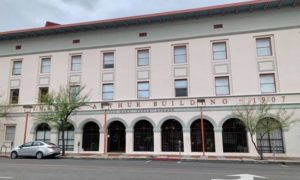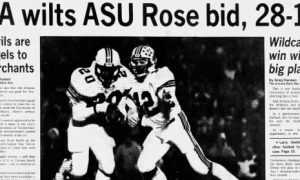[rps-paypal]
[ezcol_1half id=”” class=”” style=””]

— General history
— The games
— Comparisons then and now
— Wildcats nickname
— Military service
— Rankings
[/ezcol_1half]
[ezcol_1half_end id=”” class=”” style=””]
Excerpt from L.A. Times, Nov. 8, 1914, authored by Bill Henry:
“Arizona’s cactus-fed athletes, despite heroic efforts on the part of their two halfbacks, (Asa) Porter and (Franklin) Luis, went down to defeat before the Occidental Tigers yesterday afternoon, the tally with all precincts heard from being 14 to 0 in favor of the Tigers.
Confident of rolling up a big score, the Tigers took the field with grins on their faces, but before the game was 10 seconds old they knew they had a battle on their hands.
The Arizona men showed the fight of wild cats and displayed before the public gaze a couple of little shrimps in the backfield who defied all attempts of the Tigers to stop them.”This site will conduct a countdown in a 100-day period, leading up to Arizona’s 2014 football season-opener with UNLV on Aug. 29 at Arizona Stadium. The 100 Days ‘Til Kickoff countdown will include information daily about the historic 1914 Arizona team that helped create the school’s nickname of “Wildcats” because of how they played that fateful day against Occidental.
[/ezcol_1half_end]
[ezcol_1half id=”” class=”” style=””]
Back in 1968, they thought about demolishing old Herring Hall, the second-oldest building to Old Main on Arizona’s campus.
You get the feeling the spirits of Colonel William Herring and J.F. “Pop” McKale, two of the strongest willed people to step foot on Arizona’s campus, engulfed the proceedings and withstood the attempt of some school officials to raze the building.
McKale, who passed away a year before the Arizona officials considered tearing down Herring Hall, built Arizona’s program from the ground up in his small office at the facility after his hire 100 years ago this week. Herring, for which the building is named because he procured donations to build it in 1903, was a chancellor of the Board of Regents who carried a lot of clout.
[/ezcol_1half]
[ezcol_1half_end id=”” class=”” style=””]
[/ezcol_1half_end]

Herring Hall, the first gymnasium for sports on Arizona’s campus, after it was built in 1903 (University of Arizona Special Collections photo)
The Bisbee Daily Review reported in 1908 that Herring one evening took an ax to a locked chain that kept him and his horse carriage from entering the university. Carriages were not allowed on the campus grounds at night. Herring summoned his coach driver to retrieve an ax downtown and return so he could break open the locked chain.
Herring wanted to enter the campus to attend a scientific lecture. Once inside the grounds, Herring gave Arizona officials an earful.
“It was necessary to take some summary action to show those responsible for locking of the gates on the university driveways that they should be left open, especially on evenings when there are public lectures or entertainments at the university,” Herring was quoted as saying by the Bisbee Daily Review.
That was the last time Arizona’s campus was locked.

The 1914 Arizona football team that earned the honor of being named the first “Wildcats” was composed of (front row, left to right): Verne La Tourette, George Seeley, Leo Cloud, Richard Meyer, Asa Porter. Second row: Franklin Luis, Lawrence Jackson, Ray Miller, J.F. “Pop” McKale (coach), Turner Smith, Harry Hobson (manager), Orville McPherson, Albert Crawford, Ernest Renaud. Back row: Albert Condron, Emzy Lynch, Charley Beach, Vinton Hammels, Bill Hendry, George Clawson, Harry Turvey.
(AllSportsTucson.com graphic/Photo from University of Arizona Library Special Collections)
[ezcol_1half id=”” class=”” style=””]
Herring, an attorney who helped draft Arizona’s state constitution, was the school’s biggest booster at that time, securing donations from companies and offering gifts himself. Herring Hall was built in 1903 with a price tag of $6,675, $5,000 of which was donated by the Copper Queen Mining Company. The gift was arranged by Herring, who was legal counsel for the company.
The construction of Herring Hall is at the genesis of Arizona’s athletic facilities. Before there was a Bear Down Gym, McKale Center, Arizona Stadium and the extravagant Lowell-Stevens Football Facility, there was Herring Hall.
It was originally built as the men’s gymnasium and used for athletics from 1903 to 1925 before Bear Down Gym was built in 1926.
[/ezcol_1half]
[ezcol_1half_end id=”” class=”” style=””]
[/ezcol_1half_end]
Herring Hall subsequently housed the women’s physical education program (1925–1937), the drama department (1937–1956), the school of journalism and the radio/TV bureau (1956–1970), and the landscape architecture program (1970–1991). In the last two decades, it has been used by College of Agriculture and Life Sciences and for storage purposes.

Arizona student dance program at Herring Hall in 1914 (provided by Jake Jacobson, grandson of 1914 football team member Albert Condron)
Arizona’s first intercollegiate basketball game was played at Herring Hall a year before McKale’s arrival in the 1913-14 season. The Varsity defeated Tempe Normal (later known as ASU) 41-17. In the 10 years before that, Arizona mostly played YMCA teams from Southern Arizona and Tucson High School alumni at Herring Hall.
Herring Hall was also used as a training facility for the football team. The first floor was constructed for an open gymnasium while the basement was used for lockers, showers and weight-training purposes.
The total workout equipment cost was $1,500, according to the Report of the Governor of Arizona to the Secretary of the Interior. The facility included 96 lockers, chest weights, dumb bells, bar bells, vaulting horse, parallel bars, horizontal bars, abdominal chair, striking bag and drum, wrestling machine, wrist machine, finger machine, chest developer, chest expander and climbing rope, among other items.
Arizona’s athletes, including the 1914 football team, took turns using the five shower stalls after games and workouts.
Herring Hall was also used for assemblies and as a dance hall for students.
The original wildcat mascot, nicknamed “Rufus” arrived on campus Oct. 17, 1915, and was introduced to the student body the following day at an assembly in Herring Hall. Rufus, who was captured by Arizona right guard Charley Beach of the 1914 team, was named after Arizona president Rufus B. von Kleinsmid
Orville “Speedy” McPherson, Arizona’s fullback on the 1914 team, met his wife, Grace, at one of these dances at Herring Hall.
“When we attended dances at Herring Hall, the girls got dance programs,” Grace told the Tucson Daily Citizen in a 1968 article. “We got partners for each of the dances at the beginning of the evening and we danced with many different partners.”

Herring Hall as it stands today (Flickr commons photo)
Speedy and Grace continued their dances together for many years, another positive development that came with the construction of Herring Hall.
Arizona’s officials decided in the summer of 1968 to preserve Herring Hall and continue to use it for journalism classes and the radio/TV bureau.
The building stands today between modern buildings on campus. The sight of Herring Hall, with its four Doric columns at the front of the old brick building, seems out of place among the modern structures of large glass windows and steel.
The spirit of McKale and Herring lives on with Herring Hall still in existence. It’s fitting that the building is now associated with the study of plant life. The research involves the generation of life from the ground up. That’s exactly what McKale did for the Arizona athletic program from his small Herring Hall office starting a century ago.
ALLSPORTSTUCSON.com publisher, writer and editor Javier Morales is a former Arizona Press Club award winner. He also writes articles for Bleacher Report and Lindy’s College Sports.




























